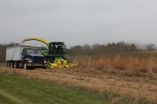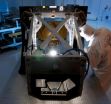(Press-News.org) MADISON – Using the meticulous phenological records of two iconic American naturalists, Henry David Thoreau and Aldo Leopold, scientists have demonstrated that native plants in the eastern United States are flowering as much as a month earlier in response to a warming climate.
The new study is important because it gives scientists a peek inside the black box of ecological change in response to a warming world. In addition, the work may also help predict effects on important agricultural crops, which depend on flowering to produce fruit.
The new study was published online today (Jan. 16, 2013) in the Public Library of Science One (PLOS ONE) by a team of researchers from Boston and Harvard Universities and the University of Wisconsin-Madison.
Compared to the timing of spring flowering in Thoreau's day, native plants such as serviceberry and nodding trillium are blooming 11 days earlier, on average, in the area around Concord, Mass., where Thoreau famously lived and worked. Nearly a thousand miles away in Wisconsin, where Leopold gathered his records of blooming plants like wild geranium and marsh marigold, the change is even more striking. In 2012, the warmest spring on record for Wisconsin, plants bloomed on average nearly a month earlier than they did just 67 years earlier when Leopold made his last entry.
"These historical records provide a snapshot in time and a baseline of sorts against which we can compare more recent records from the period in which climate change has accelerated," explains Stan Temple, a co-author of the study and an emeritus UW-Madison professor of wildlife ecology. Temple is also a senior fellow at the Aldo Leopold Foundation in Baraboo, Wis., a stone's throw from the iconic shack where Leopold made many of his observations.
Although the new study is not the first to document the relationship between temperature and flowering dates and the trend toward climate-driven early blooming, it is the first to suggest that the trend in flowering plants may continue beyond what has been observed in controlled studies. The work thus has important implications for predicting plant responses to changing climate, essential for plants such as fruit trees, which are highly susceptible to the vagaries of climate and weather.
"We used relationships revealed in historical records to predict how 47 species of native plants would respond to unprecedented spring temperatures, but that has only been possible because naturalists, past and present, kept good records of what they observed in nature," Temple avers.
Importantly, the results give scientists a peek into the subtleties of ecological change in response to climate change. Flowering of native plants, harbinger of spring in the world's temperate regions, signals the start of the growing season and changes in the timing of flowering have broad implications for the animals and insects that depend on the plants.
"Earlier blooming exposes plants to a greater risk of experiencing cold snaps that can damage blossoms and prevent fruiting," says Temple. "The Door County (Wisconsin) cherry crop was ruined in 2012 because the trees bloomed very early in response to record-breaking warmth only to be hit by subsequent frost."
The new study keyed on the detailed phenological records of 32 native plant species in Concord, Mass., kept between 1852 and 1858 by Thoreau, a pioneering naturalist best known as the author of Walden, as well as later records. A second data set of flowering times for 23 species in southern Wisconsin was compiled by Leopold, a renowned wildlife ecologist at the University of Wisconsin and author of A Sand County Almanac. Leopold and his students gathered their data in Dane and Sauk Counties between 1935 and 1945. From 1977 until she died in 2011, Aldo Leopold's daughter Nina Leopold Bradley resumed the collection of phenological records near the Leopold Shack.
"Both Thoreau and Leopold were part of the 19th century naturalist movement in which individuals often kept meticulous daily journals recording the things they observed in nature," notes Temple. "Most of those journals have been lost over time, but Thoreau and Leopold were famous writers, and their journals have been preserved, providing us with unparalleled historical data."
Comparing modern observations with those gathered by Leopold shows that in 1942, when mean spring temperature in southern Wisconsin was 48 degrees Fahrenheit, black cherry bloomed on May 31. In 2012, with a mean spring temperatures of 54 degree Fahrenheit, black cherry blooms were observed as early as May 6. In 1942, Leopold's notes show the woodland wildflower bloodroot blooming on April 12. In 2012, bloodroot was first observed blossoming March 17.
Together, these two data sets provide a unique record of flowering trends in the eastern United States over a 161-year period, says Temple.
"Leopold and Thoreau had no idea their observations would help us understand responses to human-caused climate change," says Temple. "But Leopold knew his records might be useful in retrospect when he wrote: 'Keeping records enhances the pleasure of the search, and the chance of finding order and meaning in these events.'"
###
Terry Devitt
608-262-8282
trdevitt@wisc.edu END
Would women rather "pop the question?"
Apparently not. With marriage proposals in the air around the new year, researchers at UC Santa Cruz report that both women and men tend to hold traditional views when it comes to marriage proposals.
Young adults were asked about their personal preferences for marriage traditions. Overwhelmingly, both men and women said they would want the man in a relationship to propose marriage. A substantial majority of women also responded that they would want to take their husband's last name.
In fact, not one of 136 men surveyed believed ...
Marginal lands – those unsuited for food crops – can serve as prime real estate for meeting the nation's alternative energy production goals.
In the current issue of Nature, a team of researchers led by Michigan State University shows that marginal lands represent a huge untapped resource to grow mixed species cellulosic biomass, plants grown specifically for fuel production, which could annually produce up to 5.5 billion gallons of ethanol in the Midwest alone.
"Understanding the environmental impact of widespread biofuel production is a major unanswered question ...
Understanding the human brain is one of the greatest scientific quests of all time, but the available methods have been very limited until recently. The development of functional magnetic resonance imaging (fMRI) — a tool used to gauge real-time brain activity by measuring changes in blood flow — opened up an exciting new landscape for exploration.
Now, twenty years after the first fMRI study was published, a group of distinguished psychological scientists reflect on the contributions fMRI has made to our understanding of human thought. Their reflections are published ...
MANHATTAN, Kan. -- A Kansas State University-led study has uncovered new information that helps scientists better understand the complex workings of cells in the innate immune system. The findings may also lead to new avenues in disease control and prevention.
Philip Hardwidge, associate professor of diagnostic medicine and pathobiology, was the study's principal investigator. He and colleagues looked at the relationship between a bacterial protein and the innate immune system -- a system of defensive cells that responds rapidly to an infection in a nonspecific manner.
Among ...
GREENBELT, Md. -- Engineers working on NASA's James Webb Space Telescope met another milestone recently with they completed performance testing on the observatory's aft-optics subsystem at Ball Aerospace & Technologies Corp's facilities in Boulder, Colo. Ball is the principal subcontractor to Northrop Grumman for the optical technology and lightweight mirror system.
"Completing Aft Optics System performance testing is significant because it means all of the telescope's mirror systems are ready for integration and testing," said Lee Feinberg, NASA Optical Telescope Element ...
Tropical Storm Emang continues to move through open waters in the Southern Indian Ocean and NASA's TRMM satellite noticed one area of heavy rainfall near the center.
On Jan. 16 at 0702 UTC (2:02 a.m. EST) NASA's Tropical Rainfall Measuring Mission (TRMM) satellite passed over Emang, and captured rainfall rates. TRMM identified that moderate rain was falling throughout most of the tropical cyclone, and heavy rainfall was occurring near the storm's center. TRMM estimated the heavy rain falling at a rate of 2 inches (50 mm) per hour.
On Jan. 16 at 0900 UTC (4 a.m. EST), ...
Melanomas that develop in the eye often are fatal. Now, scientists at Washington University School of Medicine in St. Louis report they have identified a mutated gene in melanoma tumors of the eye that appears to predict a good outcome.
The research is published in the advance online edition of Nature Genetics.
"We found mutations in a gene called SF3B1," says senior author Anne Bowcock, PhD, professor of genetics. "The good news is that these mutations develop in a distinct subtype of melanomas in the eye that are unlikely to spread and become deadly."
Eye tumors ...
ROCHESTER, Minn. -- A new Mayo Clinic Proceedings study shows that people most often visit their health care providers because of skin issues, joint disorders and back pain. Findings may help researchers focus efforts to determine better ways to prevent and treat these conditions in large groups of people.
"Much research already has focused on chronic conditions, which account for the majority of health care utilization and costs in middle-aged and older adults," says Jennifer St. Sauver, Ph.D., primary author of the study and member of the Population Health Program within ...
Eliminating or curtailing the mortgage interest deduction (MID) would initially result in declines in housing prices and investment but would have only modest aggregate macroeconomic effects in the long run, according to a new paper from Rice University's Baker Institute for Public Policy.
The MID is the second-largest individual income tax expenditure, according to the congressional Joint Committee on Taxation. Given the severity of the fiscal problems currently faced by the U.S., many recent tax reform proposals have included measures that would curtail or eliminate ...
NEW YORK – January 16, 2013 – EcoHealth Alliance, a nonprofit organization that focuses on local conservation and global health issues, released new research on Ebola virus in fruit bats in the peer reviewed journal, Emerging Infectious Diseases, a monthly publication by the Centers for Disease Control and Prevention (CDC). The study found Ebola virus antibodies circulating in ~4% of the 276 bats scientists screened in Bangladesh. These results suggest that Rousettus fruit bats are a reservoir for Ebola, or a new Ebola-like virus in South Asia. The study extends the range ...



